
Bullet and Splinter Wound Care Page Menu: 1 2 3 4 5 6 7 8 9 10 <<First
Bullet and Splinter Wound Care in the Golden Age of Piracy, Page 10
Step 5: Remedy Complications - Gangrene
"The most cruel Symptoms that attend Gun-shot and great contused Wounds [such as those caused by large splinters] are Gangræna and Sphacelus." (Richard Wiseman, Several Chirurgicall Treatises, 1686, p. 443)
One of the most-feared consequences of any wound was gangrene and its progeny sphacelus. According to the belief of this period, a gangrened part could still be revived, while a sphacelated part was dead and could only be removed, often by amputation, to prevent the sphacelation from spreading. Although treatment of gangrene has been discussed in its own article, most of the information on gangrene relating to gunshot and large contused wounds is presented in Richard Wiseman's book. He explains that he placed it there because "I thought fit should
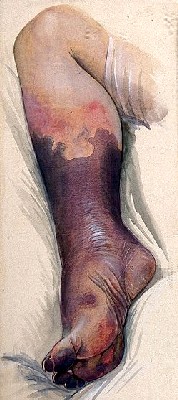
Artist: Barbara E. Nicholson
Discolored and Decomposing
Gangrened Leg (1947)
accompany Gun-shot, they of all Wounds being most subject to it."1 With this in mind, we will explore Wiseman's information relating to such wounds here.
Wiseman warns that
many Accidents are wont to happen to these [gun shot] Wounds, which not only impede the Cure, but often, without timely help, destroy the Patient. And these are vehement Pain, Inflammation, Erysipelas, from whence Gangrene and Sphaceli do frequently happen. The latter take their beginning from Inflammation.2
He notes that when these wounds are accompanied by a large tumor which changes "colour suddenly, and sink[s], the Pain continuing, and that Wound &c. grow more painful, if the Flesh also lose its ruddiness, and look pale and withered, and the Matter [discharging from the wound] change to be thin and gleety [watery], you may suspect it corrupting"3.
Wiseman further details how gangrene can be detected.
The Signs of a Gangrene are, change of natural colour in the Skin to a pale livid, with diminution of Tumour; Blisters also arise, and the Part turneth black soon after. In Wounds, the Lips sink and are flaccid; a Gleet followeth, and the Flesh within withers; also the Pulse and Sense in the Part do both languish.4
This sounds remarkably like the description of coloration of the flesh around gunshot and large splinter wounds. This is why, despite their similarity in appearance, some surgeons felt compelled to warn their readers not to treat fresh gunshot and large contused wounds as being gangrened as discussed earlier.
Like an erysipelas, the cure of a gangrene revolved around two things: humor-based treatments and medicines. (There basically is no cure for a sphacelus.) Let's look at each of these elements of cure.
1 Richard Wiseman, Several Chirurgicall Treatises, 1686, p. 446; 2 Wiseman, p. 415; 3 Wiseman, p. 444; 4 Wiseman, p. 443
Gangrene - Humor-Based Cures
Richard Wiseman explained that gangrene grows out of "Pain with Flux [flow]
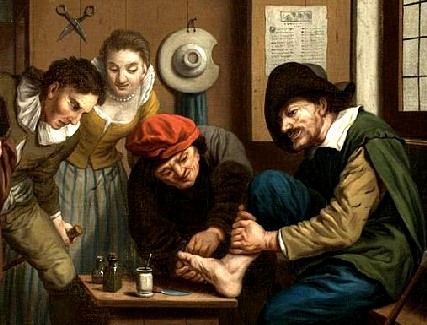
Artist: Jan Josef Horemans the Younger -
A Visit to the Physician (mid/late 18th c.)
of humours and Inflammation"1. Since humors are part of the cause, the next step is usually making sure the unwanted humors are either removed or dissipated.
Regarding humor-based treatments, Wiseman says "the Humours abounding in the body must be evacuated by Bleeding and Purging [of the digestive system]: Revulsion [moving humors away from a site through mechanical means] ought also to be made to avert the Humours from flowing to the diseased Parts"2. Revulsion can be performed by some of the methods discussed previously including letting blood in a place distant from the wound site and rubbing the site to scatter the humors.
Wiseman emphasizes the idea that gangrene can occur "by reason of the great of Humours... which have infeebled and hindred the transitus [moving] of Spirits into the Part"3. While 'spirits' sound a bit like another word for humors, but they only refer to a part of one of the four humors: blood.
According to Ambroise Paré , there are three types of spirits found in human blood: animal, vital and natural. Wiseman is here referring to the vital spirit which "flows into the whole body, to nourish the heat which resides fixed in the substance of each part"4. He is suggesting that the gangrenous symptom lack of heat is due to other humors blocking the vital spirit in the blood from reaching the part. He goes on to say that this
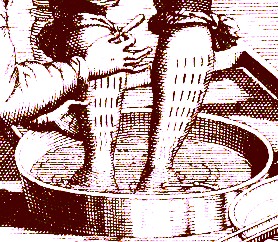
Artist: Prospero Alpini
Scarifying the Calves with a Fleam, From
De Medicinea Aegyptiocum, p. 198 (1591)
may be perceived by the Gleet [watery discharge] and change of colour, it beginning to look livid; also by a diminution of the Tumour, &c. When you see such a change begin, you must presently prepare to withstand a Mortification [sphacelus] by Scarification [making incisions in the skin to relieve the part of corrupted blood], not only until the blood come about the Lips of the Wound, but deep into it through the Eschar to the quick [living flesh], and suffer it to bleed freely, and make the Part sensibly feel, that by such means you may disburthen it of part of what would have choaked it, and make way for the entrance of the operation of ...Medicine.5
He is suggesting that deep incisions in the part will push the 'bad' humors out so that the 'good' spirits found in healthy blood will replace them. This is so important that he later reemphasizes this point, explaining that "if Tumour and Inflammation have been very great… it will be necessary that you scarifie to the quick [living skin under the surface], and make it bleed freely."6
In addition to these direct humor-based treatments, Wiseman mentions another, more indirect aspect of humoral treatment: proper diet. He advises the surgeon that when he begins to suspect gangrene, "a cooling and slender Diet ought to be observed".7
1,2 Richard Wiseman, Several Chirurgicall Treatises, 1686, p. 444;3 Wiseman, p. 416; 4 Ambroise Paré, The Workes of that Famous Chirurgion Ambrose Parey, 1649, p. 19; 5 Wiseman, p. 416; 6,7 Wiseman, p. 444
Gangrene - Medicine-Based Cures
The number of medicines that Richard Wiseman recommends for treating a gangrene are not quite as diverse as he recommended for wound healing and erysipelas. In a general sense, Wiseman says, "Cordials [medicines to encourage the heart and thus good blood production and delivery]
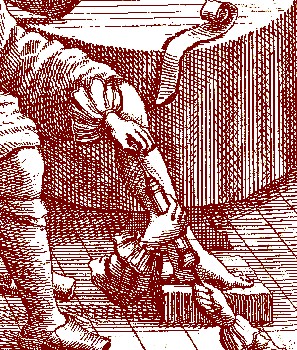
Injecting Medicine, From Clysmatica nova,
Wellcome Collection (1667)
and Epithems [topical medicines] are also necessary to resist the Putrefaction, and strengthen the Vitals, from what cause soever the Gangrene ariseth."1
To prevent gangrene (which can arise from putrefaction of the wound according to the theory at this time), sea surgeon John Woodall recommends that the "first locall application if you feare putrefaction, bee Ungu: Ægyptiacum mixed with Wine or Aquavitæ, or alone; being also very hot injected into the wound, or applied on linte."2 You may recall from the discussion on cleaning the wound that Unguent of Aegyptiacum was widely recognized as having a strong 'scouring' or cleansing ability that could remove putrefied flesh.
Richard Wiseman similarly advises its use with Venetian treacle, wine vinegar and burnt or calcined vitriol when dressing a wound suspected of developing gangrene.3 Treacle was used to ward off poisons. Wiseman is presumably using counter-poisons as a way to combat gangrene since he did not believe bullet wounds were intrinsically poisonous. Like Wiseman, John Woodall also mentions the use burnt vitriol if the Aegyptiacum failed to work.4 He likely recommended the vitriol for its ability to remove unwanted flesh as well as to heal a wound over with a scar.5
In addition to burnt vitriol, Woodall advises the surgeon to "foment [bathe] somewhat the outward parts of the griefe with hot Lixivium, and apply a hot stupe [piece of folded cloth] wet in the Lixivium & wrung out round about the member"6.
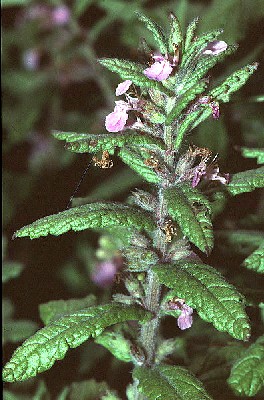
Photo: Wiki User Fornax
Teucrim Scordium Flowers
Lixivium or lye was often used to cleanse wounds of rotting flesh. Richard Wiseman also recommends bathing wounds suspected of gangrene "with a good Lixivium made of Ashes, to which may be added Salt and Vinegar. Or you may boil scord[ium - teucrim scordium or water germander] absinth. centaur[y] [apparently to be together, although he does not specifically state this]."7
Once that medicine is in place, Wiseman recommends applying "a Cataplasm ex farin. hord. [of wheat meal] fabar. [bean meal], orobi [probably vetch meal], lupinor. [meal of hops] Decocted in some of the same Lixivium, with an addition of Oxymel to it."8
After the progression of gangrene was halted and an eschar had been created over the wound, Woodall said, "it is likely you shall finde digestion [the growth of new flesh in the wound] though unperfect, namely durty and fowle, and the wound will be very tender and sensible, and subject to alteration by the ayre [air], if care be not had."9 To remedy this, he suggested applying "a very short dressing, and of as gentle medicines as may be."10 His recommended 'gentle medicines' are liniment arcei on the wound (which would cleanse it and encourage the growth of healthy flesh) with a Paracelsus plaster over that, which would serve a similar purpose.
Wiseman advises the use of similar medicines at this point to encourage the growth of new flesh in the wound "and so proceed with Sarcoticks [medicines to increase and unite the flesh] and Epuloticks [medicines to heal wounds] to finish the Cure."11 Unfortunately, he doesn't specify which medicines are to be used in these capacities.
1 Richard Wiseman, Several Chirurgicall Treatises, 1686, p. 444; 2 John Woodall, the surgions mate, 1617, p. 143; 3 Wiseman, p. 416; 4 Woodall, p. 143; 5 Woodall, p. 285; 6 Woodall, p. 143; 7,8 Wiseman, p. 416; 9,10 Woodall, p. 144; 11 Wiseman, p. 416

